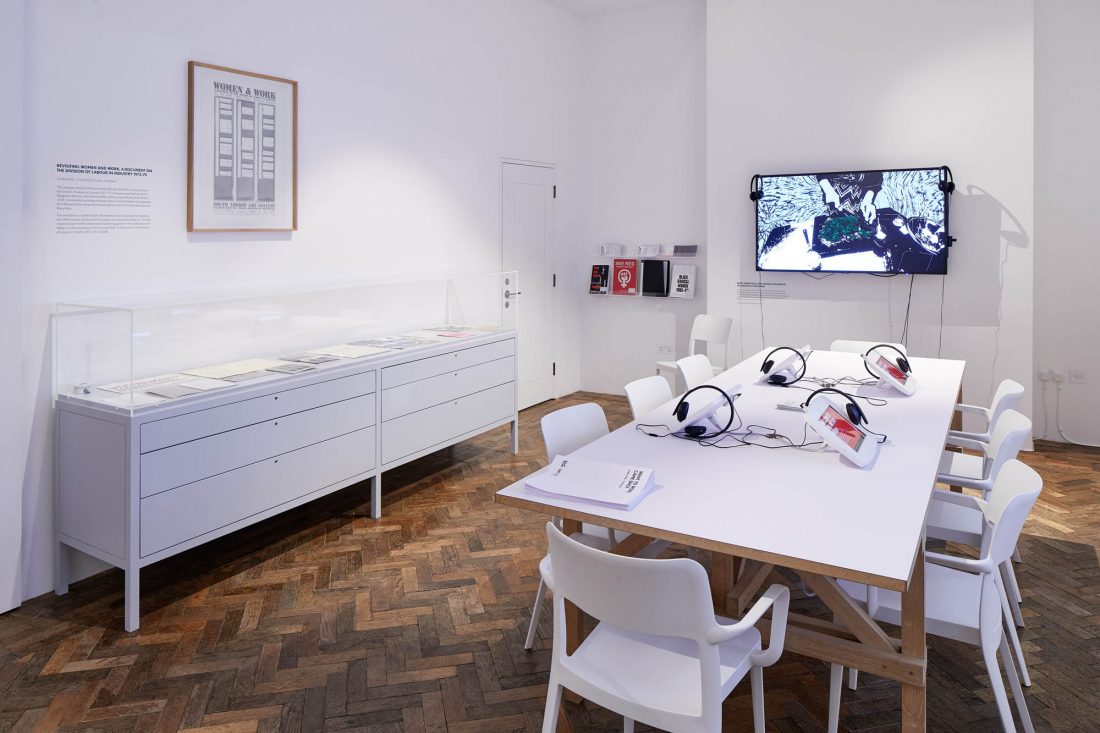
Went to work, came back panel discussion. Photo: Sam Nightingale
Went to work, came back (14 November 2018 – 17 February 2019) is an archive display and series of events exploring ethnic and gender equality in the work place. It is based on the South London Gallery exhibition Woman and Work: A Document on the Division of Labour in Industry 1973-75 curated in 1975 by Mary Kelly, Margaret Harrison and Kay Hunt. The project is the result of a six-month collaboration between curators from the MA Culture, Criticism and Curation at Central Saint Martins and the REcreative Editorial Board.
In this Journal, two curators from the MA Culture, Criticism and Curation (CCC) group discuss the development of the project.
Vanessa M. Spiridellis: How did Went to work, came back come about?
Victoire Barbin Perron: The idea emerged from one important intention and one common thread of research. First our intention was to carry out a project that would resonate both locally and globally, with a theme inscribed in the history of south London. Secondly, during our archival research at the South London Gallery, Black Cultural Archives and Southwark Library we found that the topic of women’s emancipation and artists’ unions kept recurring. When we learnt about the exhibition Women and Work in the SLG archive, we instantly knew that it would be the perfect foundation to reflect on questions of gender and equality, particularly in relation to the arts and heritage.
VMS: Why did you choose to explore the theme of gender and ethnic equality in the workplace with three different formats of events? (i.e. archive display, panel discussion and artist-led workshop)
VBP: We wanted to provide context for the 1975 exhibition with the archive display Revisiting Women and Work which presents photographs of the installation, information about the political context of the time and an interview we conducted with one of the three curators of the exhibition, Mary Kelly.
We also wanted to bring the concerns of the curators in 1975 into the present realm. We felt that the most suitable form for this was in a panel discussion, since it offered the opportunity to gather different voices and foster a discussion with a wider audience. We invited curator E-J Scott, artists Adelaide Damoah and Andrea Francke, and historian Dr. Caitríona Beaumont. It was very important that we had different cultural and artistic professions represented, as well as genders, ethnicities and orientations in order to elicit the well-rounded, inclusive discussion we were aiming for.
Last but not least, we strongly believe in participatory art and in the engagement of the public. So, in addition to initiating a discussion between an audience and panellists, we decided to curate a workshop with artist and activist Andrea Francke where participants could be more actively involved through creative activities and conversation.

Installation view of Revisiting Women and Work, Archive, South London Gallery Fire Station. Photo: Andy Stagg
VMS: What were the biggest challenges that you faced during the development of the project?
VBP: Everyone involved in the project agreed that it was a very instructive experience. We managed to turn all the project’s challenging aspects into productive assets. We made the most of our large group of curators (about 20 individuals throughout the project) by utilizing our different backgrounds (academic, professional, personal), and by implementing efficient means of communications and organisation. We also made the most of our collaboration with the South London Gallery, whose reputation helped us to raise the visibility of the important topics we wanted to explore.
VMS: What is the most valuable lesson that you have learned from this collaboration?
VBP: Any goal can be achieved providing that efficient and relentless work is put in!
VMS: Does Went to work, came back have a future?
VBP: Our archive display, Revisiting Women and Work is open to the public at the SLG Fire Station until 17 February 2019. As far as follow-ups are concerned we have prepared the grounds for further research by documenting the workshop and the panel discussion. We have also included punch cards within the archive display in order for visitors to contribute their own experiences related to identity and work, so that the spirit of documentation from the original exhibition continues.